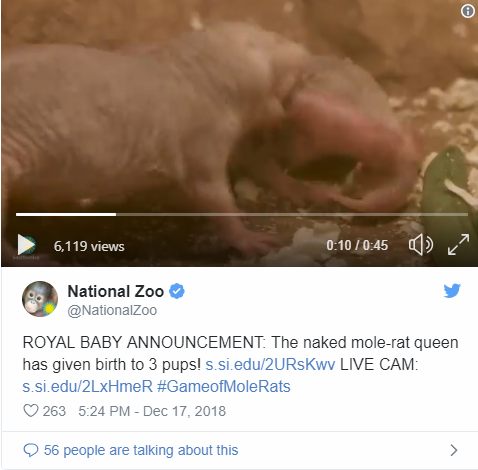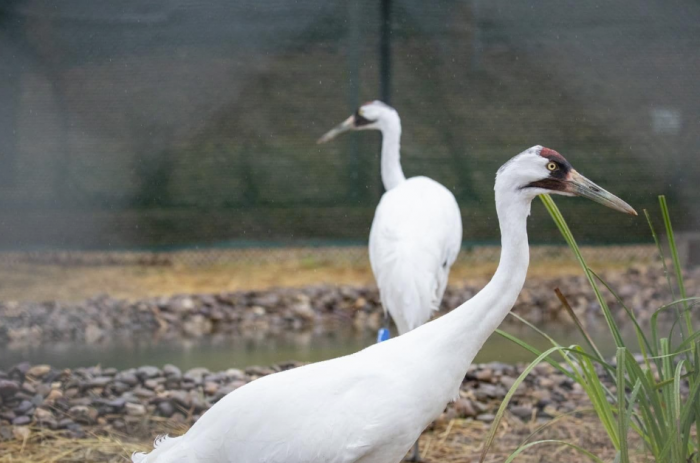ICYMI: Highlights from the week that was Dec. 16 – Dec. 22, 2018
No one can keep up with everything, so let us do it for you. We’ll gather the top Smithsonian stories from across the country and around the world each week so you’ll never be at a loss for conversation around the water cooler.
Among the vicious political infighting taking place in Washington the week before Christmas, a clear winner emerges: Queen of the Naked Mole Rats.

Take a dive into Smithsonian’s massive and amazing ‘whale warehouses’
The Washington Post, December 16

Emily Graslie, host of “The Brain Scoop” channel on YouTube, tours the Smithsonian’s whale warehouses in Suitland, Md. (Michael McGowen)
Earth’s biggest animals live and die in the ocean. But a few whales have long afterlives in museums — and the Smithsonian’s National Museum of Natural History boasts the world’s largest collection of whale material.
But all those bones present a tricky challenge. The massive specimens, among the largest ever collected, take up tons of space. So the museum houses them in its half-a-million-square-foot “whale warehouses” in Suitland, Md. Read more from Erin Blakemore for the Washington Post.
The Best Art Books of 2018
The Times’s art critics select some of their favorite art books and books related to art of the year.
The New York Times, December 13

Among Roberta Smith’s picks are, from left: “Posing Modernity: The Black Model From Manet to Matisse to Today”; “Between Worlds: The Art of Bill Traylor”; and “Hairy Who? 1966-1969,” open to three works by Karl Wirsum. Eric Helgas for The New York Times
From a catalog that sheds new light on black models of mid-19th-century French painting to a collection of mid-1980s art criticism by the novelist and playwright Gary Indiana, the best art books of the past year provided a balm for turbulent times. Below, the New York Times’s art critics choose some of their favorites. Read the complete article:The Best Art Books of 2018 – The New York Times
This Dracula Antʼs Jaws Could Make It the Fastest Animal on Earth
You could call it an ant speed record.
The New York Times, December 13

Mystrium camillae, an elusive species of Dracula ant. Adrian Smith
The Dracula ant is not much of a traveler. Located mostly in the tropics of Africa, Australia and Asia, the tiny creatures spend most of their lives burrowed into tree trunks or underground, to the endless frustration of scientists who would like to study them.
So, imagine the surprise of the researchers who recently discovered that Dracula ants may be the fastest animals on earth. Read the entire article: This Dracula Ants Jaws Could Make It the Fastest Animal on Earth – The New York Times
Legendary Home Brewer Bids Farewell With A New Craft Beer Using Smithsonian Hops
Forbes, December 18

Charlie Papazian, “The Father of Home Brewing,” will leave the Brewers Association trade group on his 70th birthday next month, but he found time this month to finish a new beer made with hops from the Smithsonian’s garden.CHARLIE PAPAZIAN/BREWERS ASSOCIATION
Dubbed “The Father of Home Brewing,” veteran brewer Charlie Papazian was honored when he received a special shipment this year from horticulturists at the Smithsonian Institution in Washington.
The shipment contained 10 sealed plastic bags filled with partly dried Cascade hops grown in the Victory Garden at the National Museum of American History. Read more from Gary Stoller for Forbes.
Big day at the zoo as naked mole-rat queen is revealed
The Washington Post, December 18

She is small and many would not find her particularly attractive or intelligent. But among her breed, she has just been confirmed as a queen.
On Monday, a petite and unprepossessing member of an exotic mammalian species was at last hailed at the National Zoo as the true queen of Washington’s naked mole rats.
“After months of anticipation, the naked mole-rat colony at the Small Mammal House at the Smithsonian’s National Zoo finally has a queen,” the zoo announced on Monday.
In its announcement, the zoo noted that by the laws of biology and zoology, the only breeding female in a naked mole-rat colony is the queen. Read more from Martin Weil for The Washington Post.
Rejoice, for the Naked Mole Rats Have Chosen Their One True Queen
New York Magazine, December 18

Smithsonian National Zoo photo
Washington, D.C., has been in the throes of an indisputably ugly, often viscous power struggle for months now. But, at long last, we seem to have reached a tenuous peace: the Smithsonian National Zoo’s naked mole-rat colony has finally chosen their one true queen.
DCist reports that four mole-rats have died since the battle began. “Yeah, they’ve been fighting and killing each other,” zookeeper Kenton Kearns said. “They have mole-rat wars to determine who’s going to be the queen or who’s going to breed with the queen. We’re hoping things will calm down a little bit now.” Read more from Gabriella Paiella for New York Magazine
The Mandarin Duck and Avian Art at the Cooper Hewitt
The Mexico City-born designer Rebeca Méndez’s new exhibition includes some two dozen taxidermied birds.
The New Yorker, December 24
For the past several weeks, New Yorkers have been abuzz over a mysterious visitor. A mandarin duck, an intricately colored waterfowl native to East Asia, has taken up residence alongside the mallards in the Central Park Pond, drawing crowds and inspiring memes, dog costumes, and a Twitter account (bio: “I’m not from around here”). Pundits have argued that the frenzy betrays a desire for good news. But perhaps, the Mexico City-born designer Rebeca Méndez suggested the other day, something deeper is at play. “In our own normal life, we have patterns that we are so used to. When something”—an anatine interloper, say—“comes in and breaks that, it’s incredibly exciting,” she said. “The world suddenly collapses—it’s like a wormhole from far-east Asia to Manhattan.” Read more from Dylan Kerr for The New Yorker.
Whooping crane breeding program to begin at Smithsonian facility
The Washington Post, December 19

Decked out in white plumage, the two long-legged, long-billed creatures depicted are among a dozen whooping cranes brought Sunday to a Smithsonian facility in Virginia for breeding. (Smithsonian Conservation Biology Institute/National Zoo photo .)
Whooping cranes, long-legged birds that have seemed for years to tremble on the brink of extinction will again be bred in captivity in the Washington region, according to an announcement from the National Zoo.
Only last month it was reported that a decades-old breeding program at the Patuxent Wildlife Center in Maryland was coming to an end.
But on Tuesday, the zoo and the Smithsonian Conservation and Biology Institute announced the start of a new breeding and research program at the institute’s facilities in Front Royal, Va. Read more from Martin Weil for The Washington Post
Where, exactly, is the edge of space? It depends on who you ask.
With more countries and commercial companies heading into the stratosphere, the debate about how to define outer space is heating up.
National Geographic, December 20

The moon seems to hang in the balance between Earth’s atmosphere and the blackness of space in a picture taken from the International Space Station.
PHOTOGRAPHY BY REID WISEMAN, NASA
ASK SOMEONE WHERE outer space is, and they’ll probably point at the sky. It’s up, right? Simple.
Except, no one really knows where “air space” ends and “outer space” begins. That might sound trivial, but defining that boundary could matter for a variety of reasons—including, but not limited to, which high-flying humans get to be designated as astronauts.
Now, with Virgin Galactic seemingly on the cusp of launching paying passengers onto suborbital trajectories, many people are wondering whether those lucky space tourists will earn their astronaut wings. As of right now, they will, according to U.S. practices.
Is that a problem? “No, I think it’s great!” says NASA astronaut Mike Massimino, who helped repair the Hubble Space Telescope.
Here, we take a look at the ways space is currently defined, the confusion surrounding the demarcation, and what the future might bring. Read more from Nadia Drake for National Geographic.
With spending bill stalled, federal agencies prepare to cease operations at midnight Friday
The Washington Post, December 20

House Speaker Paul Ryan departs the House Chamber on Thursday. (Bonnie Jo Mount/The Washington Post)
The collapse of talks between President Trump and Republican leaders to keep the government funded temporarily left dozens of federal agencies facing the prospect of closing at midnight Friday, with officials offering scant details on what operations would continue on the eve of the Christmas holiday weekend.
A partial shutdown seemed increasingly likely, with hopes dwindling of an agreement to fund the Departments of State, Agriculture, Interior, Treasury, Justice, Commerce, Homeland Security, Transportation, and Housing and Urban Development and the Environmental Protection Agency, as well as dozens of smaller independent agencies. Read more from the Washington Post.
Posted: 23 December 2018






